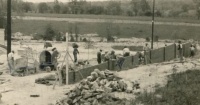Char Adams
char.adams@nbcuni.com
(Black PR Wire) For more than 80 years, Morgan State University students walking down Hillen Road near the school’s entrance saw a massive red brick wall. Some thought it was a simple alley; others thought perhaps it protected a few garages. But the structure was actually a “spite wall” intended to keep Black students from venturing into a once predominantly white Baltimore neighborhood.
White Baltimore residents banded together in the late 1930s to erect the wall in response to the growing number of Black people in the area attending Morgan State, a historically Black institution. Recently, University President David Wilson, school officials and residents watched as an excavator destroyed the barrier.
“We had no choice but to tear it down,” Wilson said in an interview. “We couldn’t have this symbol of hate staring down every single day. This was an easy decision for us. It was time for us to tear down that hate.”
The wall was built along Hillen Road in front of the school’s entrance and stretching past Northwood Shopping Center in the early 1940s after years of debate and opposition. Residents and neighborhood associations in the predominantly white city already had qualms with the school when it moved to its current location in 1917, Wilson said. The state’s decision to change what was then Morgan College from a private institution into a public one in 1939 to help Black people only “exacerbated” the racial strife, Wilson said. It happened as Baltimore began to adopt restrictive racial covenants limiting where Black people could live — Baltimore was among the first cities to adopt such practices.
The Baltimore Afro-American newspaper published articles chronicling the debate: College trustees called plans for the wall “discriminatory to Morgan College,” while Morris Macht, part of one of Maryland’s largest residential building companies at the time, denied that it had anything to do with race. Ultimately, a zoning board approved the wall, and construction began in 1942, according to the Afro-American.
“For the white community, this spite wall was to send a signal and to physically create a divider that would symbolize the segregation that they stood for,” said Dale Green, a professor and architectural historian at Morgan State. “They were not supportive of the integration of African Americans into the greater society. The wall was to fortify the whites from the Blacks.”
The barrier remained for decades, even as Morgan State students fought for civil rights in the 1960s, staging one of the nation’s first anti-segregation sit-ins at the Northwood Shopping Center across the street from the campus.
Destroying the wall is part of a major reconstruction and expansion at the university called “Morgan Momentum,” said Cheryl Stewart, a spokeswoman for Morgan State. So, she said, now is a great time to “remove the wall so we can continue to build and move forward.”
Over time, the history of the wall faded into obscurity, its original intent known only by a few. But Wilson said the university doesn’t plan to ignore the past now that the wall is gone. Instead, he said, officials plan to keep a small part of the wall in place as a historical marker where students can learn about its dark history.

